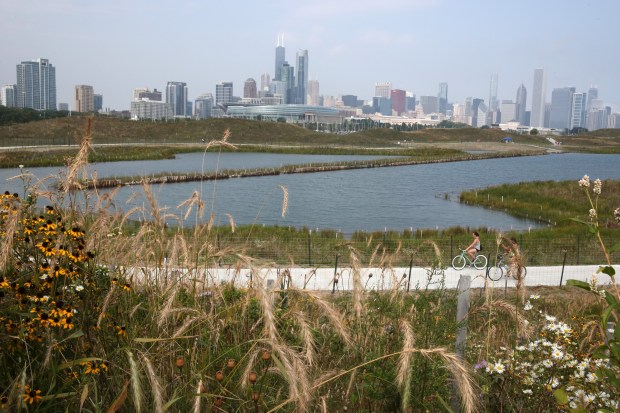Millions of public dollars and lots of planning have been poured into Northerly Island, but the nature preserve was nearly desolate on a sunny Saturday afternoon in late August. Meanwhile, North Side beaches, Grant Park and the Museum Campus were buzzing with locals and tourists alike.
Matthew Bregg, 33, discovered Northerly Island on a bike ride shortly after he moved to the Lakeview neighborhood two years ago. He said he walks or bikes through the preserve about once a month, and on this most recent expedition, he brought five friends visiting from across the country.
“It has one of the best views of the skyline. It’s just gorgeous,” he said.
During its colorful history, the manmade island was the center of the Chicago World’s Fair from 1933 to 1934, made the short list of potential United Nations headquarters in 1945 and had a stint as an airport for elite business travelers until it was abruptly closed by former Mayor Richard M. Daley in a controversial move in 2003.
Today, Northerly Island houses a seasonal music venue and the little-known nature preserve. Waves smash against the shore, testing the structural integrity of a manmade seawall. A singular access point makes traffic terrible on concert days and leaves the island eerily quiet otherwise. A century after it was built, Northerly Island exists with no clear purpose.
The city has wiped its hands, with the Chicago Park District, which oversees the island, declaring itself “proud of the work (it has) done to transform Northerly Island.”
“Past proposals for more extensive developments at Northerly would come at great cost and further burden to taxpayers,” said Park District spokeswoman Michele Lemons.
It wasn’t long ago, however, that the city toyed with improvements to the island. The most recent proposal was created under then-Mayor Lori Lightfoot in 2022. It would have increased accessibility and transformed the island into a climate education hub.
The Johnson administration is not pursuing any of those recommendations, according to a city spokesperson.
So, is this it for Northerly Island?
Ambitions fall short
The lone island on the southern end of Chicago’s lakefront was supposed to “belong to the people” and “be treated as park space,” per Daniel Burnham’s 1909 Plan of Chicago. The renowned urban designer envisioned it as the northernmost point in a string of manmade islands on a lagoon between Grant and Jackson parks.
Eleven years after he published his plan and eight years after he died, Chicago voters approved a $20 million plan to dredge the lake and build the 91-acre island. But none of the other islands were built, and Northerly Island was later connected to the Museum Campus, technically making it a peninsula.
“Northerly Island is critical to the experiential cohesion of the Museum Campus,” said Shedd Aquarium President Bridget Coughlin, citing the campus as a place where people can play, commune with nature and learn. In addition to the aquarium, it’s home to the Field Museum of Natural History and Adler Planetarium.
“The very beauty (of Northerly Island’s nature preserve) is that it is natural and remote. The irony is that it’s inaccessible.”
She was part of a diverse working group of leaders in Chicago’s hospitality, business, realty and nonprofit sectors convened by Lightfoot in February 2022 to rethink the Museum Campus. They had lofty goals for the island.
-
Bridges could make the nature preserve more accessible to visitors.
-
The old airport terminal turned visitor center — which is closed due to fire damage — could become a “Great Lakes Climate Lab” that explores nature-based solutions to climate change for shoreline communities.
-
Huntington Bank Pavilion, a 30,000-seat music venue, could be replaced with a lower-profile amphitheater.
-
The southern tip of Northerly Island could be the point for an iconic sculpture like Cloud Gate, more commonly known as The Bean.
-
Floating restaurants could be added along the northern seawall for visitors snorkeling, boating and deep-water swimming in a new humanmade lagoon.
These ideas echoed many of the recommendations in a 2010 plan commissioned by the Park District and completed by local architecture firms Studio Gang and SmithGroupJJR. The award-winning architects envisioned a renovation that would add 12 acres of fish spawning habitat, 40 acres of migratory bird habitat and 19 acres of wetland.
“Imagine canoeing through calm lake water to quiet off-shore islands, hiking an island oasis under shade provided by a thriving woodland canopy, or discovering a remote rocky beach with breathtaking views. Imagine all of this within walking distance of Chicago’s bustling urban center,” the architects wrote in the plan.
But, like Northerly Island’s sister islands, the 2010 plan was never realized. It was too expensive, ringing in at $40 million: nearly four times the project budget.
Instead, the Park District, in collaboration with the U.S. Army Corps of Engineers, pursued a pared-down $10.7 million version of the plan partially funded by the U.S. Environmental Protection Agency’s Great Lakes Restoration Initiative. It focused on reintroducing native species by planting over 300,000 plants and 400 trees to encourage the return of local birds and insects.
The nature preserve opened to the public in 2015, but it began deteriorating within years.
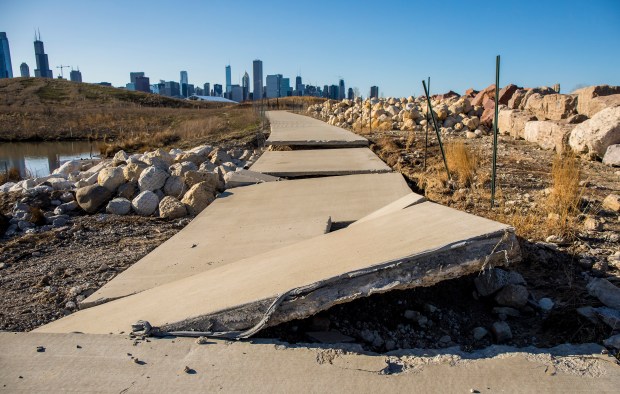
Aggressive wave action and strong storms — both intensified by climate change — eroded the eastern side of the island. Barrier islands and reefs proposed by the architects in the $40 million plan would have been nature-based solutions to reduce weathering.
The Army Corps, however, could only afford to stack rows of large rocks along the shore. By 2019, that rock wall had to be bolstered, and a year later, the eastern side of the path was closed. The path that once let visitors make a full loop around the island is now a horseshoe shape.
“In a perfect world, (the barrier islands and reefs) could come back, but it would be a huge investment,” said Alex Hoxsie, the Chicago District Army Corps’ chief of environmental and cultural resources. The Army Corp’s scope of work with the city ended in 2022.
Plans abandoned yet again
Paul Siu, 55, was one of the few people who ventured into the nature preserve on that recent August afternoon.
He has lived in the Chicago area since the mid-2000s but this was his first time there. The two other times he tried to go, it was blocked off due to concerts.
“It’s a little smaller than I thought, but it’s cute,” Siu said. “I was just looking at some of the flowers.”
Purple, yellow and white wildflowers were plentiful among the green and brown prairie grass tucked away behind a hodgepodge of chain link fences and parking lots that support Huntington Bank Pavilion, the seasonal amphitheater operated by event conglomerate Live Nation.
The concert venue “contradicts the island’s identity as a nature haven,” according to the 2022 report, which went as far as suggesting to dismantle it.
Cars honked as they inched along the one road that leads to Northerly Island and peddlers hollered that they had great deals on alcohol last Wednesday evening ahead of a Glass Animals concert.
“Park closed for a permitted event,” read a sign propped up against a police line.
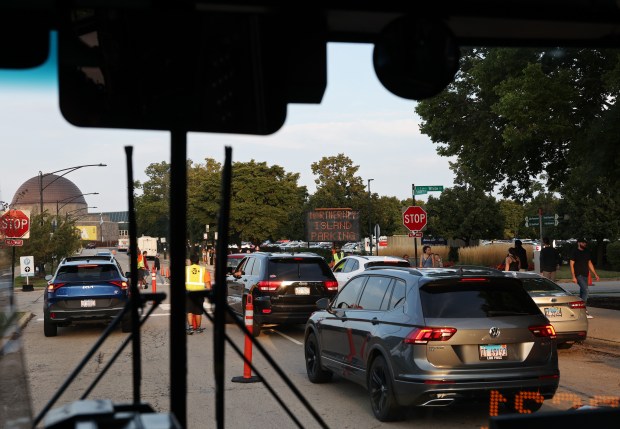
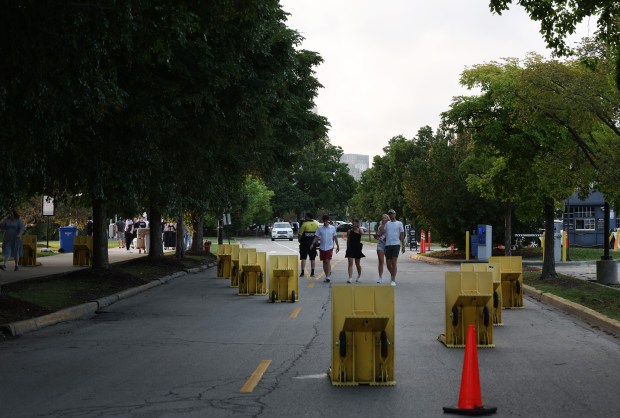
Like the 2010 architects, the 2022 Museum Campus Plan suggested replacing Huntington Bank Pavilion with a smaller amphitheater to maximize the island’s natural spaces. It proposed a new outdoor concert venue adjacent to Soldier Field, which has recently come under threat.
Mayor Brandon Johnson has thrown his support behind a controversial new lakefront stadium for the Chicago Bears that, if approved, would likely result in Solider Field being torn down.
His administration has no plans to pursue any of the 2022 plan’s recommendations beyond expanding the native gardens around the museums and some areas of Northerly Island, according to a statement from the city.
“I hate to see the (Museum Campus) plan die, but the city is facing so many challenges like the Bears Stadium. This is clearly not the priority,” said Gerald Adelmann, former president and CEO of Illinois-based conservation organization Openlands and a 2022 working group member.
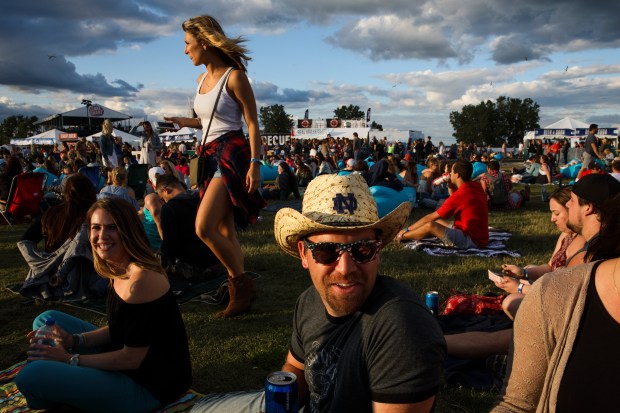
Coughlin, the Shedd’s president, and Field Museum President Julian Siggers — two fellow working group members — are hopeful the city will lead a coordinated effort to see the full plan to fruition one day. In the meantime, their nonprofit museums have been complementing the city’s efforts by independently planting native gardens on their properties.
The Shedd is also taking summer campers on short excursions to collect water samples from the preserve’s lagoon. The plan proposed a significant expansion of similar educational programming with the creation of a Great Lakes Climate Lab.
Located next to three of the nation’s leading science museums, on the shore of the world’s largest freshwater system and in the nation’s third-largest city, Northerly Island is superbly positioned to teach people about nature-based solutions to climate change, Adelmann said.
“Cities are at the forefront of the future of our planet in terms of climate; 80% of Americans live in metropolitan areas, 50% of the world. And, so, the impacts of climate are felt most dramatically in cities — and of course island nations.”
The surging waves that eroded and permanently shut down part of the preserve trail in 2020 are a reminder of climate change’s influence on the lakefront.
Never for the people
Northerly Island hasn’t garnered the cultural capital of other Chicago public parks like Grant Park and Millennium Park.
Some say the city should relegate large events that receive mixed feelings from residents for closing down streets and public parks, such as Lollapalooza and NASCAR, to Northerly Island.
“Having these festivals out there would be less disruptive to the central city and its functions,” said Ward Miller, CEO of Preservation Chicago, a nonprofit dedicated to preserving the city’s built environment. “You not only have streets blocked off, but you have admission fees, and you have lots of fencing and grandstands that often damage the landscape.”
This ambivalence toward Northerly Island is partially because it’s been difficult to reach. There is only one entrance to the island and that becomes particularly congested during concerts. The 2022 plan proposed making the preserve more accessible by adding two bridges.
“It was never really for the people,” said Adelmann, who visited the city regularly while growing up 45 minutes away in Lockport in the 1960s.
For over 50 years, the island operated as an airport that gave businessmen and politicians from Springfield easy access to downtown Chicago, effectively cutting the island off from average citizens.
“It was really a place off-limits unless you were flying,” said Adelmann. “Maybe I could have gone out to the terminal. I don’t even know, but it wasn’t inviting.”

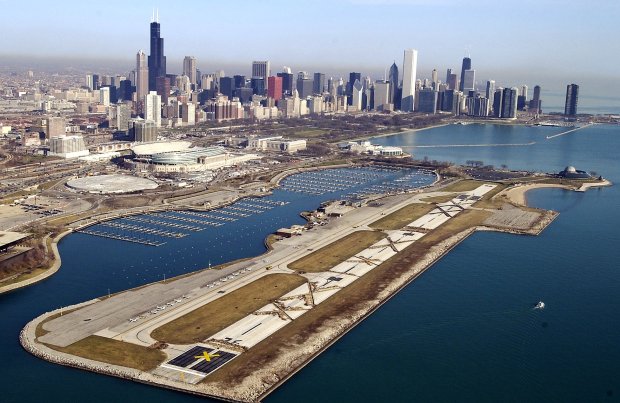
Burnham’s original idea of Northerly Island being a nature space for the people never died, though.
During their mayoral terms, Richard M. Daley and his father, Richard J. Daley, sought to transform the island from a private airport to a public park. The younger Daley visited Openlands to share his vision for the island, recalled Adelmann, who led the organization for 35 years. He wanted a snorkeling bay, a stargazing hill and botanic gardens.
After the airport lease was extended against his wishes, Daley ordered city crews to gouge six X’s into the runway in the middle of the night. The unsanctioned move was a death sentence for the airport. The damages were too costly to repair, opening the door in 2003 for Northerly Island to finally become a park.
“They can question Daley’s tactic and what he did, but it should be, it was meant to be, always, public open space,” Adelmann said.
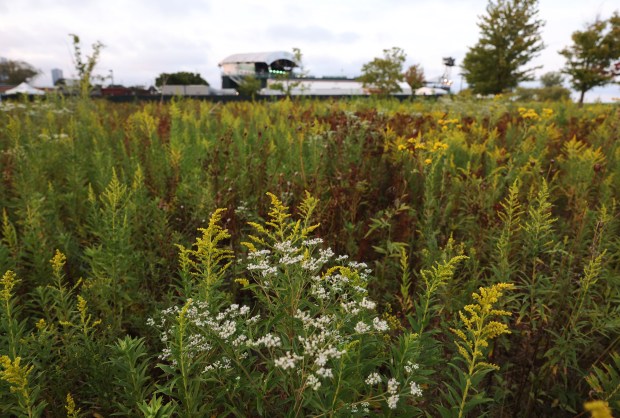
But, empty on a prime summer weekend, it doesn’t appear to have lived up to its promise. And, for now, the reintroduction of native plants and relatively modest weatherproofing completed by the Army Corps a few years ago appears to be it for Northerly Island.
Burnham’s 1909 nature-based plan transformed into the Daley mayors’ vision, which was rolled over into the 2010 proposal and, most recently, the 2022 Museum Campus plan. But they all remained just that: a plan.
“Good ideas have to survive one administration after another. That’s what I’m hoping with this plan. (The 2022 plan) is not the Lightfoot plan. It’s the city plan,” said Adelmann.


